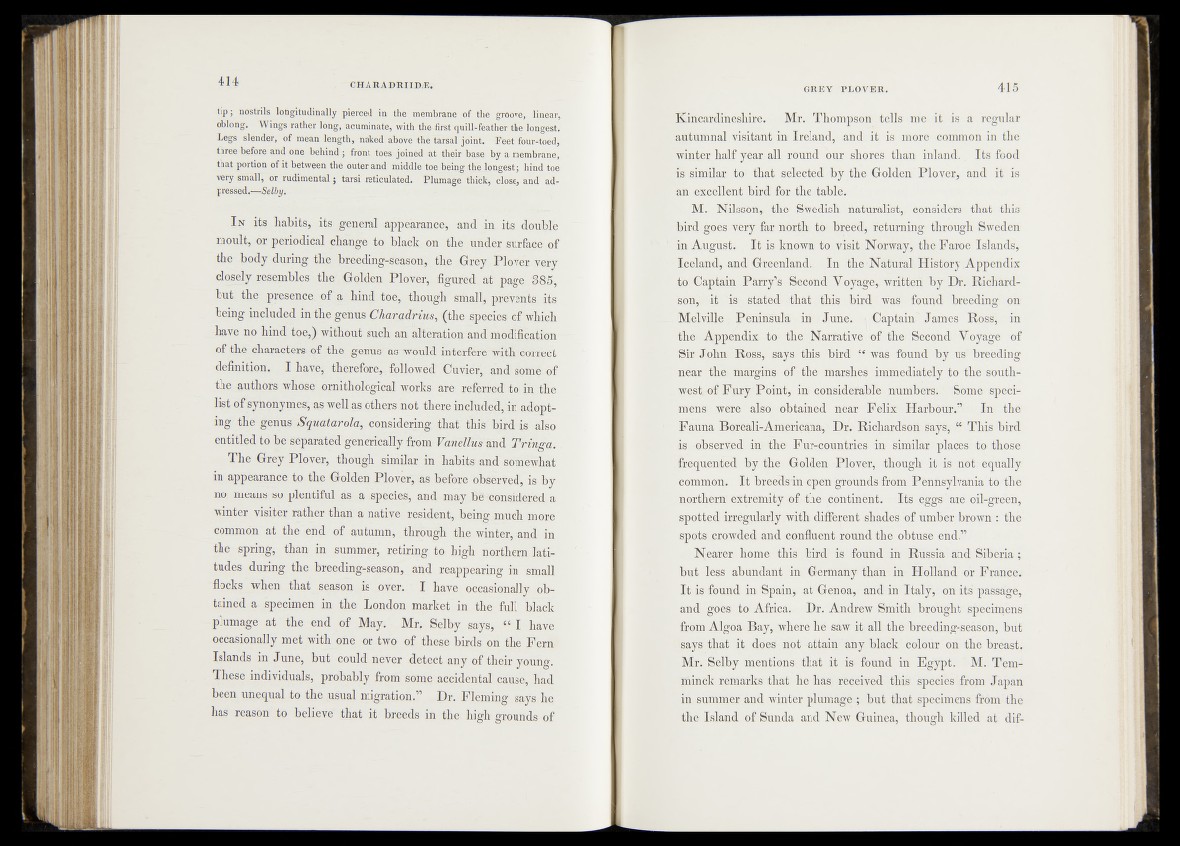
tip; nostrils, longitudinally pierced in the membrane of the groove, linear,
oblong. Wings rather long, acuminate, with the-first quill-feather the longest.
Legs slender, of mean length, naked above the tarsal joint??11 ^FëélplraF-lfoecl,
three before and one behind j front toes,-joined at their base, by a membrane,
that portion of it between the outer and mjddle foe being the longest; fiJkM toe
very smalt; or. rudimental; tarsi' reticulated. Plumage' thick, f e , and 'ad-
pressed.—Selby.
I n its habits, its general appearance, anti in. its double
moult, or periodical change to black on thejuirider sj£r%e ©f
the body during the breeding-season, thje Grey-Plqj^^fg^y
closely resembles-the’ Golden Plover, figured-at' page£3|$ ,
but the presence, of a hind toe, though’ small, preyeixts? its
being included in the genus Charadrius, (the^ecjes; ofVhipè
have no hind toe,) without such an alteration and modi^at^Q~
of the characters, of the genus* as~would ihJiëtfërë^xlË ^correct
definition, I have, therefore^ followed Chtierb-^nd ^ 9^ ^© f
the authors whose ornithological xyqrks are; 'referre'd l^fddhe
list o f synonymes, as well as othqrsmot there iheïiidedyin adopting
thé genus Squatarola, considering that this? bird is also
entitled to be separated generically from Vanéllüs and Tringa..
The Grey Plover, though similar in habits and^som^liat
in appearance to the Golden Plover; as before observed, is by
no, means so plentiful as a species, and-.may -l^óénsijfeced a
winter visiter rather than a native, resident, being jnuohfmpe
common? at the end of autumn, through the winterhand in
the spring, than in summer,' retiring to, high northern latitudes
during the breeding-season, and reappearing in'small
flocks when that season is over. I have occasionally obtained
a. specimen in the London market in the full black
plumage a t | the end of May. • Mr, Selby says, “ I havé
occasionally met with one or two of thege birds on the Fern
Islands in June, but could never detect any of their young.
These individuals, probably from some accidental cause, had
been unequal to the usual migration.” Dr. Fleming says he,
has reason to b e lie # that it breeds in the high grounds of
Kincardineshire. Mr. Thompson tells me it is a regular
autumnal, visitant in Ireland, and it - is idifore common in the
wilder half year» all round our plljpfds than inland. Its food
us sinfilar .to- that^sejjcjefcd,'by the GoldenOplover, and it is
an pxceli€Ht third for tbe.dable.
M3iii|^ifesion,> ’tli^Swedish ha#ralfet, considers that this
b irdlffi^^ ely far norths, l^freeedt, returning fWwgh Bwedeu
in » la giaafe -;I||rs known-l)^ visit^N orw-ayj the Faroe "Islands,
and Greenland.- IjplB ‘Natural History Appendix
# j& f e iin PafrvfigJ l l ed.ftd Voyage^ wrilten^lp Dr. Richard^-
t^Ori*#' it- is stated^ that this bird was? feffind breeding on
Melville,- 'M^nS^nla1 in' June. ttGaj^ain? Jam?# Ross, in
t h ^ 4-ppepdix» to f ^ N a r r a t iv e ©f the ^edfed-' Yoyage of
sptejohm R'dss, sayjaf this *, bird ?e- was'r foundfvby1"dsffbreeding
near th e margin^' e$rthe marslfes > im m e^ ^mawl thpfsoxith-'
WGst^jj|l|FjxryiPoint, in considerable numbers. - Some- speci-
‘mw . »were alto obtainetd^ near Felix Harbour.” In H e
F^fna Boreali-i^feri^^Sii^Dr. Richardson say-s^ 4 This bird
is i|||>#LYed"- in'd’be Fur-coun’ttxes in- Similar ) plfecl^feb, those
,-frequ^fii^fd by though it is riot equally
<©ommop., It bree.dsin ©pen grounds from Pennsylvania to the
, northern e&fe^mity th e continent. It^^gsffare oil-green,
^pblHH'irregularly with different shades of umber brown : the
. spots?,eroyjded .and confluent round the obtuse'end*.” '
jfj^vearcr | home - this bird is found in Russia 'and Siberia ;
but less abundant dri" Germany than in Holland or Frarip?.»-
lM|tfourid in Spain,- at Gel®,, and'an'Ttaly," ©if its passage,
and to Africa,*« Dr; Andrew Smith brought specimens
from-Algoa B ay ^ h e re h'e saw it all thehreeding-season, but
says that ft riot -attain any'black 'colour on the breast.
Mr. Selby mentions that it is found in Egypt. M. Tempi
in ck remarks that he hasureeeived this species ^from Japan
in summer and winter plumage; but that specimens from the
the Island of Sunda and New Guinea, though killed at dif